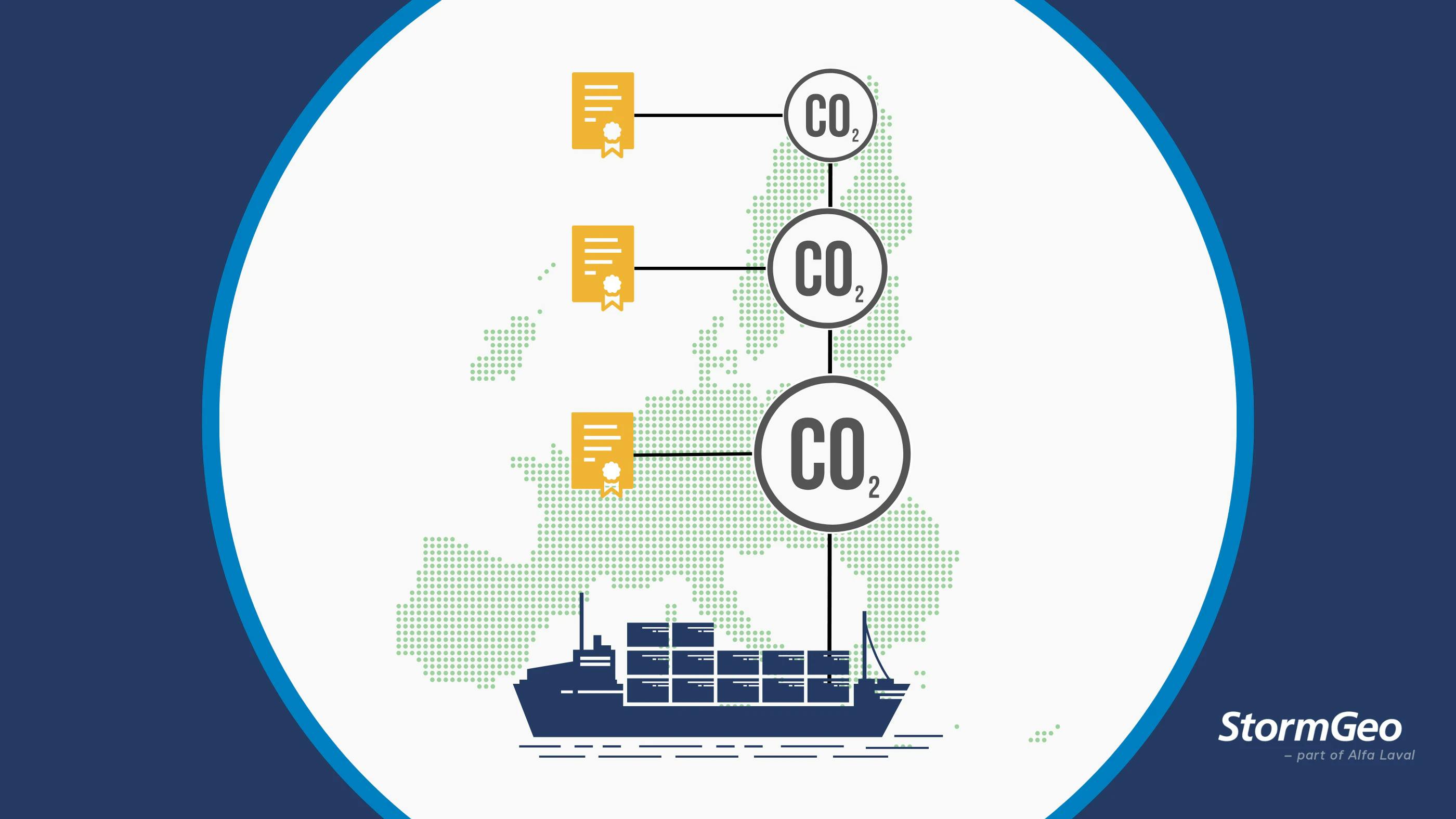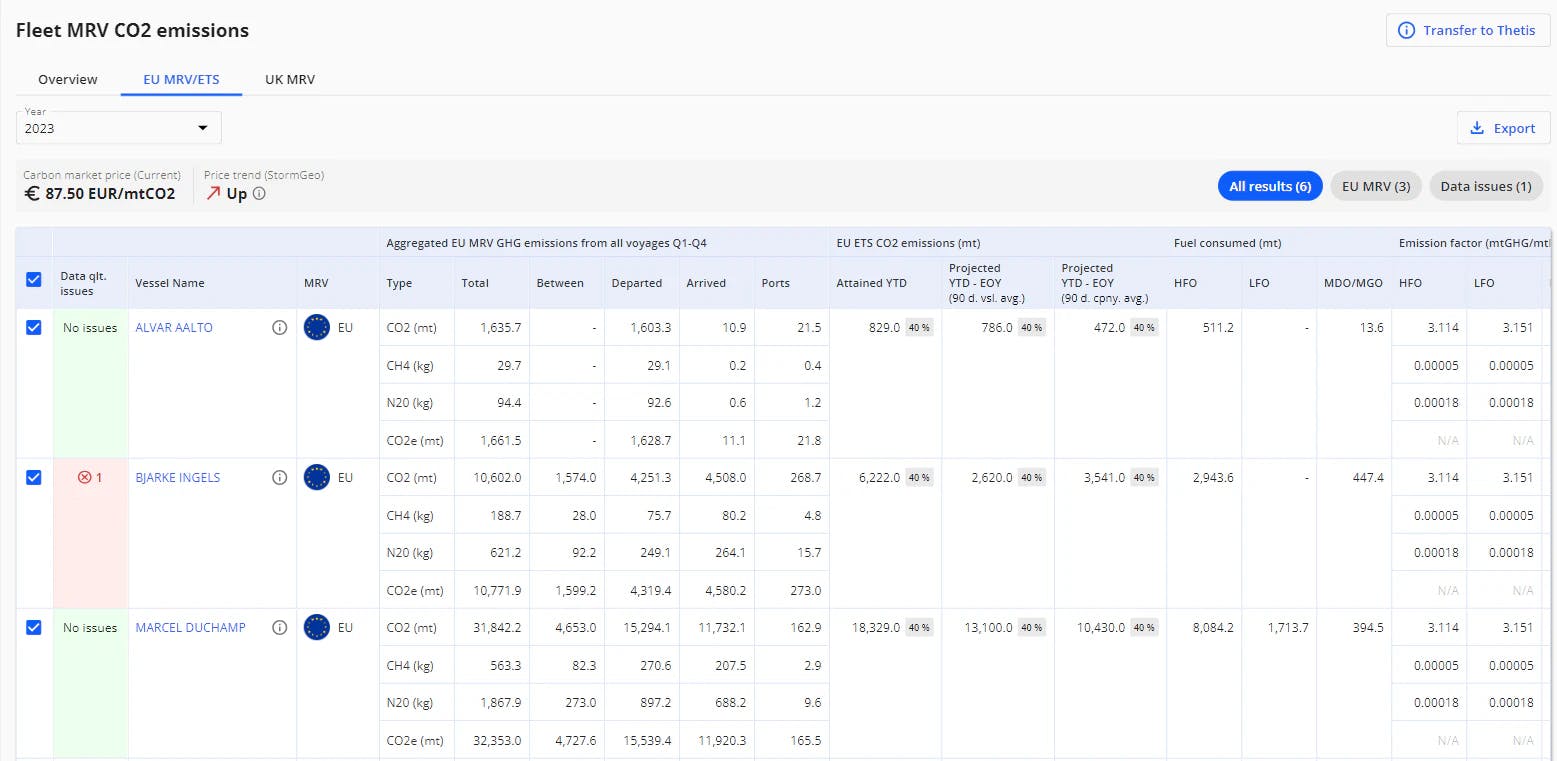Contact us
Reach out to us and a representative from one of our 26 worldwide office locations will contact you shortly.
Please login to your designated client portal:
Guide - January 17, 2024

The EU ETS is an emissions cap-and-trade mechanism that aims to reduce GHG emissions that derive from different industries. Companies that fall under the EU ETS directive need to monitor, report, and pay for their emissions by purchasing EU Allowances (EUAs), equivalent to the amount of GHG that they emit.
With the EU ETS to include shipping from 2024 as a measure to support decarbonization in the maritime industry, we asked our Environmental Regulations Experts to answer key questions on what this directive is about and how shipping companies can become compliant without reducing operational efficiency.
A1: The European Union aims to reduce its emission by 55% in 2030 compared to 1990. The measures to reach the target are laid out in Fit for 55 package which extends the Emission Trading System to the shipping sector. The shipping industry is required to reduce the total volume of GHG gradually over time. Every company with ships trading in the EU/EEA is required to surrender emission allowances corresponding to a certain amount of its GHG emissions emitted over a calendar year starting with 2024. The requirements apply to the shipping company, which is the shipowner or any other entity responsible for the ship operation and duties imposed by the ISM Code. The shipping company is responsible for surrendering allowances but can contractually pass on the costs to another entity operating the ship.
The emission allowances must be bought through an auction system. The company is only allowed to emit up to the amount which is covered by their allowances otherwise additional allowances have to be obtained. There will be only a limited amount of emission allowances available for the industry to obtain and to trade. This amount will be gradually reduced on an annual basis; minus 4.3% from 2024 to 2027 and minus 4.4% from 2028.
The price per ton of emissions varies. The generated revenue will go into an innovation fund to decarbonize shipping and to EU member states to finance climate and energy-related projects.
A2: Ships above 5000 GT transporting cargo or passengers for commercial purposes within the EU are required to acquire and surrender emission allowances for their CO2 emissions starting from 2024, regardless of the flag they fly. General cargo and offshore ships between 400 – 5000 GT are currently under evaluation if they should be included to the EU ETS scheme while offshore ships of 5000+ GT will be included from 2027.
A3: On voyages and port calls within the EU/EEA, 100% of emissions will account for EU ETS, while for voyages into or out of the EU/EEA only 50% of the emissions are subject to EU ETS.
Container vessels stopping in transshipment ports outside the EU/EEA but less than 300 nm from an EU/EEA port, need to include 50% of the emissions for the voyage to that port as well, rather than only the short leg from the transshipment port. This means that 50% of emissions for voyages to/from a transhipment port outside the EU and to/from an EU port shall be accounted for in EU ETS. The European Commission will publish the list of transshipment ports by 31 December 2023 and update it every two years thereafter.
A4: Starting from 2024, EU ETS will include CO2 emissions only while EU MRV scheme is extended to include reporting of methane (CH4) and nitrous oxide (N2O). From 2026, the EU ETS scheme is also foreseen to include methane and nitrous oxide.
The emissions in scope for surrendering allowances will be gradually phased-in, starting with 40% of carbon emissions in 2024, increasing to 70% for 2025 and to 100% for 2026 onwards.
Certain activities may be exempted or have reduced obligations by surrendering allowances. As these could be subject to change, StormGeo recommends seeking detailed information from the administrating authority or the accredited verifier.
A5: The emissions must be reported through the existing EU MRV scheme, which is revised and extended. For reference see Regulation (EU) 2023/957 amending Regulation (EU) 2015/757.
The shipping company has three months from January 2024 to review the existing EU MRV Monitoring plan to amend the methods for monitoring and reporting reflecting the inclusion of methane and nitrous oxide. The plan then has to be verified by an accredited verifier and submitted to the administrating authority of the shipping company for approval by April 1st, 2024.
The EU ETS compliance scheme is set on an annual basis and subject to shipping company level. Thus, the shipping company needs to appoint an accredited verifier on fleet level.
By March 31st each year from 2025, a verified company emission report needs to be submitted to the administering authority, aggregating the emissions reported and verified for each ship under the responsibility of the company during the reporting period respectively calendar year.
By September 30th each year from 2025, the necessary emission allowances are required to be surrendered to the administering authority.
Further reference is laid out in Regulation (EU) 2023/959 and its amendments. For interpretation and clarification of the regulation, seek guidance from your accredited verifier or administrating authority.
A6: If a company fails to surrender allowances, it is held liable to an excess emissions penalty of currently €100 per metric ton CO2. Furthermore, the company still has the obligation to purchase the required allowances corresponding to the quantity of emitted emissions. In case of persistent non-compliance for two or more consecutive periods, companies may be denied entry into the EU for their entire fleet until the obligations are fulfilled.
A7: The emission factors to be applied are defined in Annexes I and II to Regulation (EU) 2015/757, which was adopted on October 12th this year by the European Commission. However, if the shipping company burns biofuel that meets the sustainability and GHG emission-saving criteria as defined in Directive (EU) 2018/2001 and is certified accordingly, then a derogation from the standard emission factors applies. In this case, the carbon emission factor of the biomass fraction shall be zero. Reference is provided in Directive 2018/2066, Article 54, Specific provisions for Biofuels.
A8: At this point, StormGeo does not offer a trading platform for purchasing EUAs. However, StormGeo enables the shipping company to improve the EUA strategy in terms of estimation accuracy and providing useful information such as carbon market prices and cost trends.
The European Commission has appointed the European Energy Exchange (EEX) as a common auction platform allocating allowances for EU emissions. While on the primary market, emission allowances can be acquired through auctions, on the secondary market, the emission allowances can be traded bilaterally or through derivatives offered by financial institutions.
In order to purchase emission allowances, shipping companies have to open a holding account in the Union Registry. However, this will not be possible before February 2024, once the administering authorities for each company are published by the European Commission.
A9: Yes, StormGeo has developed a scalable EU ETS solution which enables the user to:

A10: The StormGeo EU ETS solution enables ship owners and charterers to monitor and validate their emissions, assess the number and costs of required EUAs, optimize their EUA purchasing strategy with key insights about the carbon market prices and facilitate data sharing with key stakeholders.
With data accuracy being crucial to a successful EU ETS strategy, the StormGeo EU ETS solution has been purpose-built to support ship owners and charterers with data validation, accurate forecasting, and seamless data sharing. As a scalable solution, more EU ETS features will be available in the coming months, according to the market needs and regulatory updates such as parceling to distribute the carbon emissions among individual cargo owners.
You can contact your local sales representative within StormGeo for product-related information and recommendations to proactively prepare for compliance with EU ETS.